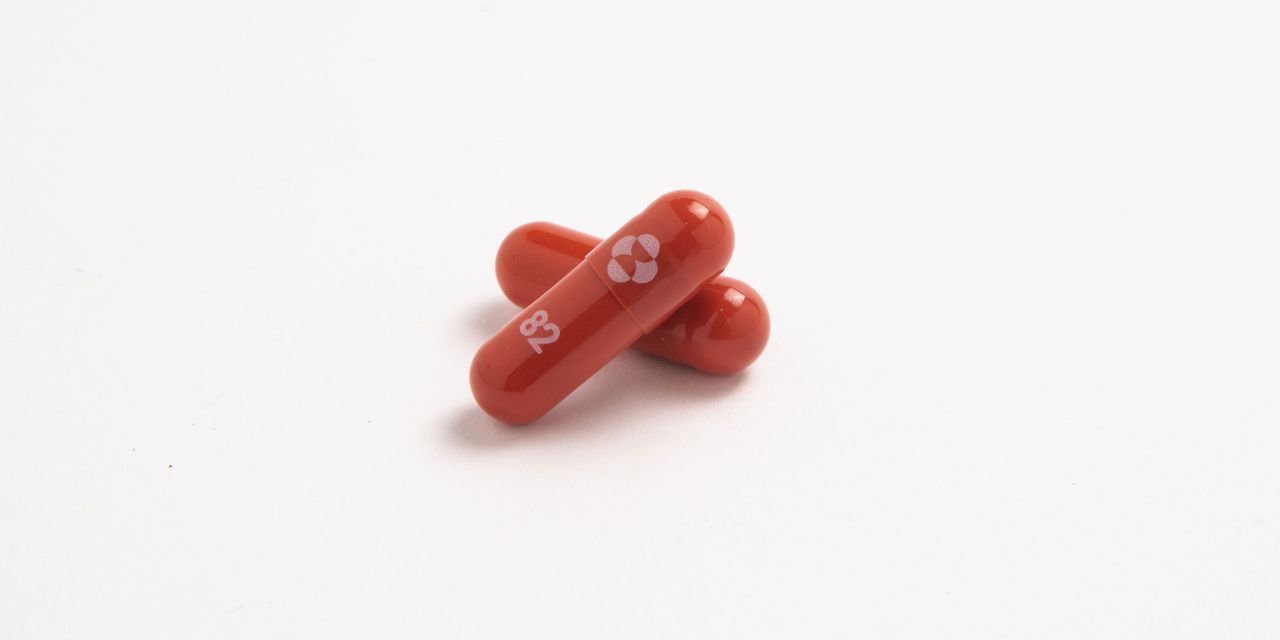
In the not-too-distant future, you may be able to walk into a doctor’s office, get tested for SARS-CoV-2, and walk out with pills or a prescription if you end up testing positive for the virus.
“Finally, we have another potential tool,” Dr. Anthony Fauci, director of the National Institute of Allergy and Infectious Diseases and chief medical adviser to President Joe Biden, said Oct. 6 at a White House briefing, “a promising new oral drug that people could take at home soon after COVID-19 to reduce the risk of severe outcomes.”
The drug is molnupiravir, which Merck & Co. Inc. MRK, and Ridgeback Biotherapeutics say cuts the risk of hospitalization and death by 50%. It’s currently under review at the Food and Drug Administration, and, if authorized, it will be the first oral antiviral to treat COVID-19 patients in the U.S.
At least three other oral COVID-19 pills are expected to have clinical data by the end of the year, including drugs developed by Atea Pharmaceuticals Inc. AVIR, -2.89% and Roche Holding AG ROG, +0.87%, Fujifilm Holdings Corp. JP:4901 (via a consortium of drug makers including Appili Therapeutics Inc. APLIF and Dr. Reddy’s Laboratories Ltd. RDY, +0.84% ), and Pfizer Inc. PFE, -0.43%.
Shionogi & Co. Ltd. 4507, +0.82% also has an oral antiviral in a late-stage clinical trial in Japan.
“Coronavirus disease is going to be with us for the foreseeable future, even if it goes endemic,” said Dr. Carl Dieffenbach, director of the AIDS division at NIAID and the official running the government’s $3.2 billion COVID-19 antiviral program. “These pills could be incredibly valuable [in] keeping the brushfire beaten down.”
It makes sense that pharmaceutical companies are trying to figure out whether antivirals can reduce the risk of someone dying or ending up with organ damage and an expensive hospital stay.
They are also evaluating whether these pills can reduce viral load or how long a person who has contracted COVID-19 is infectious or sick — or even prevent people from ending up with long COVID.
“If there’s something that can reduce viral load effectively, it would both reduce the risk of severe symptoms and potentially long COVID symptoms in that individual themselves and then, obviously, also reduce the risk of spreading the virus to others,” said Dr. Carolyn Bramante, a pediatrician with the University of Minnesota Medical School, who is leading a clinical trial of repurposed drugs like ivermectin and metformin as COVID-19 treatments.
If molnupiravir and other antivirals are authorized or approved, it’s going to matter how quickly they are prescribed, if it’s best to prescribe them after someone is exposed to the virus or once symptoms are reported, and whether patients will comply with taking multiple pills in a single day.
“The oral antivirals, by virtue of how they work, need to be taken early in the course of disease, certainly within five days,” said Dr. Armand Balboni, CEO of Appili, which is working with Fujifilm to develop the COVID-19 pill favipiravir. “I would argue that probably three days is where we need to use it, almost exactly like we use Tamiflu.”
Roche’s influenza drug, Tamiflu, which can be used as a treatment or for post-exposure prophylaxis, needs to be taken within 48 hours of symptoms to work effectively.
Experts often compare SARS-CoV-2 to HIV or influenza. Both are transmittable viruses that are best treated when someone who is infected gets access to care quickly. How those viruses act in response to antiviral treatments can provide insight into several factors, including when to expect the virus’s resistance to therapies and how quickly treatment needs to start with COVID-19 patients.
“The goal is to fundamentally get to a place where people who are diagnosed with coronavirus disease would start the medication as soon as possible after they’re diagnosed,” Dieffenbach said. “If it’s set up in a logical, systematic way, you could leave either with pills or a prescription for the medication at the time you test. In HIV, we call that test-and-treat.”
But that may be difficult for the already disconnected healthcare system in the U.S. Making sure that people get tested right away, even after potential exposure to COVID-19, is one challenge. Ensuring that they follow through with getting a prescription and taking several pills per day could be another obstacle.
Patients in the Merck trial took four pills twice a day for five days, for example, while Fujifilm’s favipiravir is testing 90 tablets in 10 days. Pfizer’s experimental antiviral requires two pills per day for five days.
That said, the only treatments available for people with mild to moderate cases of COVID-19 are monoclonal antibodies, which have to be administered in a doctor’s office and are intended only for those who are at risk of severe disease. “You get an infusion,” Dieffenbach said. “It’s not a trivial thing.”
Because the monoclonal antibodies haven’t always been easy to get access to, that has hindered their utilization, especially among people in rural America who live dozens or even hundreds of miles from the nearest hospital or clinic.
“We need this because we need a toolbox,” Balboni said. “The toolbox absolutely includes vaccines. But it also includes monoclonal antibodies. It includes broad-spectrum oral antivirals and probably stacking the broad-spectrum oral antivirals to ensure that we don’t develop resistance.”
Read more of MarketWatch’s coverage about COVID-19 antivirals:
Why a pill you take at home could change the direction of the pandemic
This development may fully reopen the global economy — and the stock market has mostly ignored it
‘It’s not a magic pill’: What Merck’s antiviral pill could mean for vaccine hesitancy





